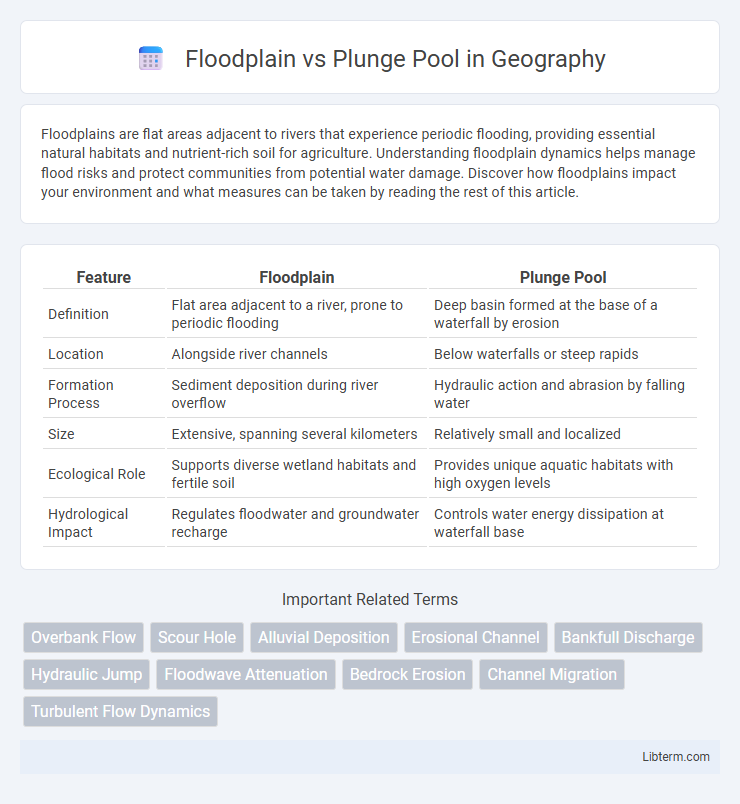Floodplains are flat areas adjacent to rivers that experience periodic flooding, providing essential natural habitats and nutrient-rich soil for agriculture. Understanding floodplain dynamics helps manage flood risks and protect communities from potential water damage. Discover how floodplains impact your environment and what measures can be taken by reading the rest of this article.
Table of Comparison
| Feature | Floodplain | Plunge Pool |
|---|---|---|
| Definition | Flat area adjacent to a river, prone to periodic flooding | Deep basin formed at the base of a waterfall by erosion |
| Location | Alongside river channels | Below waterfalls or steep rapids |
| Formation Process | Sediment deposition during river overflow | Hydraulic action and abrasion by falling water |
| Size | Extensive, spanning several kilometers | Relatively small and localized |
| Ecological Role | Supports diverse wetland habitats and fertile soil | Provides unique aquatic habitats with high oxygen levels |
| Hydrological Impact | Regulates floodwater and groundwater recharge | Controls water energy dissipation at waterfall base |
Understanding Floodplains: Definition and Characteristics
Floodplains are flat, low-lying areas adjacent to rivers and streams that periodically experience flooding, acting as natural buffers by absorbing excess water during heavy rainfall or snowmelt. Characterized by nutrient-rich sediments deposited through recurrent inundation, floodplains support diverse ecosystems and fertile agricultural land. These zones play a crucial role in water filtration, groundwater recharge, and habitat provision, distinguishing them from plunge pools--depressions formed by erosive water action at the base of waterfalls.
What is a Plunge Pool? Key Features
A plunge pool is a deep, basin-like depression formed at the base of a waterfall due to the erosive force of falling water and sediment. Key features include its significant depth relative to the surrounding riverbed, steep sides, and smooth-bottomed cavity created by hydraulic action and abrasion. Unlike floodplains, which are flat, fertile areas alongside rivers prone to flooding, plunge pools are confined, underwater potholes that help dissipate energy within river channels.
Formation Processes: Floodplain vs Plunge Pool
Floodplains form through the lateral erosion and deposition of sediments during overbank flooding events, where rivers overflow their banks and spread sediment across adjacent land areas. Plunge pools develop at the base of waterfalls due to the hydraulic action and abrasive force of falling water, which scours and deepens a depression in the bedrock. These distinct formation processes reflect the dynamic interactions between fluvial erosion and sediment transport in different river environments.
Hydrological Roles of Floodplains
Floodplains act as natural buffers by absorbing excess floodwater, reducing peak discharge and mitigating downstream flooding, while plunge pools primarily function as erosion basins at the base of waterfalls or steep streams. The hydrological role of floodplains includes groundwater recharge through infiltration and sediment deposition that enhances soil fertility and water retention. These dynamics support ecosystem stability and help regulate flow regimes during storm events.
The Geomorphology of Plunge Pools
Plunge pools are deep, erosional basins formed at the base of waterfalls where plunging water exerts significant hydraulic action and abrasion on the bedrock, highlighting key aspects of geomorphological processes in fluvial environments. These geomorphic features contrast with floodplains, which are relatively flat, depositional areas adjacent to rivers characterized by sediment accumulation and periodic inundation. Understanding plunge pool formation involves analyzing factors such as water velocity, turbulence, rock resistance, and sediment load, which collectively influence the pool's depth, shape, and evolution.
Biodiversity: Floodplains Compared to Plunge Pools
Floodplains support higher biodiversity than plunge pools due to their extensive area, diverse habitats, and varying water levels that create rich environments for numerous plant and animal species. These ecosystems host complex food webs featuring amphibians, birds, insects, and fish reliant on the dynamic flood regime. In contrast, plunge pools, while providing important microhabitats for certain aquatic organisms, have limited spatial range and species diversity compared to the vast, nutrient-rich floodplain systems.
Floodplain Ecosystem Services
Floodplains provide critical ecosystem services such as nutrient cycling, water filtration, and habitat biodiversity, supporting diverse plant and animal species while mitigating flood impacts. They act as natural buffers that absorb excess water during flooding events, reducing downstream flood damage and maintaining groundwater recharge. In contrast, plunge pools primarily function as erosional features at the base of waterfalls or rapids, focusing on sediment transport rather than broad ecosystem services.
Erosional Impact: Plunge Pool Dynamics
Floodplain areas experience gradual erosion through sediment deposition and surface runoff, shaping wide, flat landscapes over time. Plunge pools form at the base of waterfalls where falling water scours bedrock, resulting in intense localized erosion and deep, circular basins. The erosional impact of plunge pools is significantly more focused and powerful, leading to rapid bedrock removal compared to the diffuse, slower erosion typical of floodplains.
Human Influence on Floodplains and Plunge Pools
Human influence on floodplains includes urban development, agriculture, and dam construction, which alter natural water flow and increase flood risks by reducing the floodplain's ability to absorb excess water. In plunge pools, recreational activities and infrastructure building near waterfalls can modify sediment transport and water erosion patterns, potentially destabilizing the ecosystem. Both floodplains and plunge pools face challenges from pollution and land-use changes that disrupt their natural functions and ecological balance.
Floodplain vs Plunge Pool: Comparative Summary
Floodplains are broad, flat areas adjacent to rivers that experience periodic flooding and facilitate sediment deposition, promoting fertile soil development. Plunge pools are deep, circular basins formed at the base of waterfalls due to erosive force from falling water, characterized by turbulent flow and scouring action. Floodplains support rich biodiversity through nutrient recycling, whereas plunge pools contribute to landscape sculpting by continuous rock erosion and sediment transport.
Floodplain Infographic

 libterm.com
libterm.com